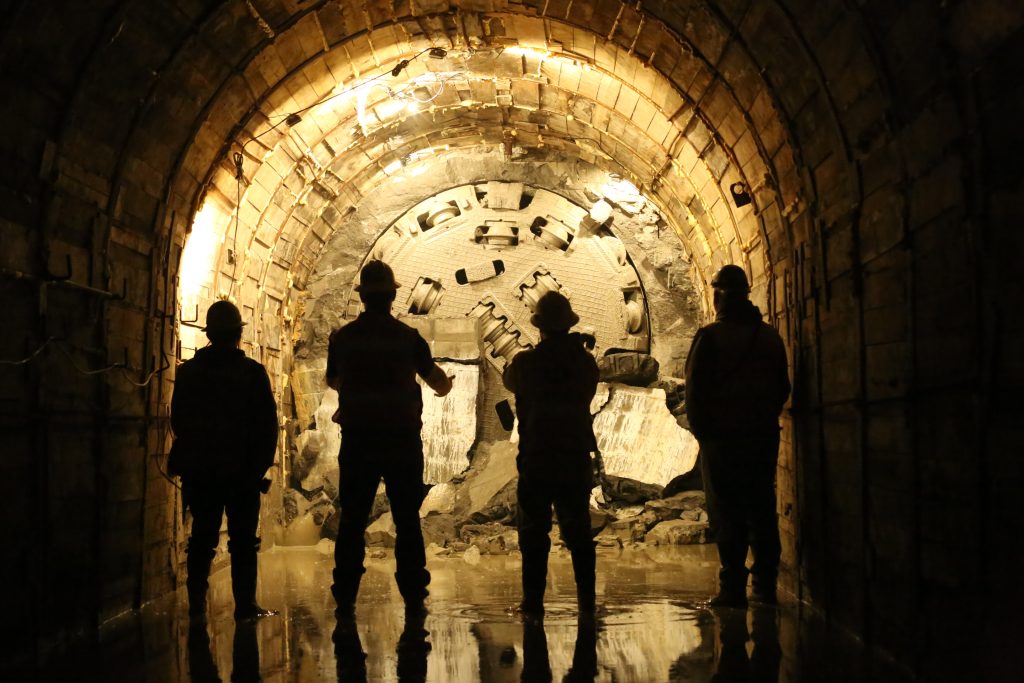Archives

Schoharie Reservoir Outlet Project – Featured Archive
Schoharie Reservoir Outlet Project – Featured Archive https://www.southlandholdings.com/wp-content/uploads/2024/03/COOL-Hole-Through-Pic-1024x683.jpg 1024 683 Southland Holdings Southland Holdings https://www.southlandholdings.com/wp-content/uploads/2024/03/COOL-Hole-Through-Pic-1024x683.jpgBefore any soil is excavated, the groundwork for a successful tunneling project is laid. This holds true for the Schoharie Reservoir Low Level Outlet (LLO) microtunneling project, situated in Gilboa, New York.
According to Project Manager John Arciszewski, meticulous planning was paramount for this undertaking. While microtunneling itself isn’t exceptionally daunting, Arciszewski pointed out that the 9.5-foot diameter Microtunnel Boring Machine (MTBM), and the depth of the shaft, reaching 160 feet, presented unique hurdles.
“Problem-solving and figuring out how to overcome challenges are some of the best parts of the job,” Arciszewski said.
Managed by the New York City Department of Environmental Protection (NYCDEP), the Gilboa Dam controls Schoharie Creek to form the Schoharie Reservoir, a crucial water source supplying 15% of New York City’s water. Awarded in 2015 to a joint venture between Southland Holdings’ companies, Southland Contracting, Inc., and Oscar Renda Contracting, Inc., the $142.6 million project aimed to construct an outlet facilitating water regulation, maintenance, emergency response, and habitat enhancement downstream.
The previous LLO had been inactive since the 1960s due to sediment blockage at the inlet.
“Critical infrastructure plays a vital role in our daily life ,whether we realize it or not,” said Southland Holdings Principal Tim Winn. “Completing the Schoharie Reservoir Low Level Outlet not only improves the function of the dam, but continues providing drinking water to millions of residents of New York”.
Tunneling Triumph
Excavation for this project encompassed both challenging terrains: hard fractured rock and soft ground with cobbles. The primary tasks involved laying down 2,210 linear feet of nine-foot ID permalock casing through microtunneling, alongside the excavation of a 40-foot-diameter by 187-foot-deep gate shaft using drill and blast methods.
The tunneling efforts were segmented into a land leg and a water leg. The land leg spanned 1,225 feet, with a portion excavated using sequential excavation methods near the portal. On the other hand, the water leg extended 950 feet and was excavated by the Microtunnel Boring Machine (MTBM) through mixed terrain: starting in rock, transitioning through till, traversing lake bottom sediments, and concluding in tremied low-strength concrete at the approach to the intake structure.
A notable milestone in July 2019 was the wet retrieval of the MTBM from the reservoir bottom by Southland Contracting crew members, marking another significant achievement for the project.
“We were uplifted by the overall success achieved per our plan.” said Arciszewski. “It was definitely gratifying for everyone involved.”
NYCDEP officials were also happy with the progress.
“The completed excavation and retrieval of this tunneling machine are major milestones in our work at the Schoharie Reservoir,” NYCDEP Commissioner Vincent Sapienza said in a released statement. “The net release works and upgrades to our intake structure at the reservoir will provide DEP with more operational flexibility to send the best-quality drinking water to New York City, and support the ecological health of the Schoharie Creek.”
Both hydraulic and mechanical dredging methods were employed to excavate approximately 12,000 cubic yards of material from the reservoir bottom. A 35-foot-diameter cofferdam was installed at the reservoir bottom to facilitate the retrieval of the MTBM, and establish the underwater connection for the intake. Approximately 7,000 cubic yards of tremie concrete were utilized to secure the intake structure, following which, the MTBM was meticulously lifted from 160 feet below the water’s surface.
The MTBM, a pioneering creation by Herrenknecht, a German construction equipment manufacturer, was equipped with explosion-proof (Class I, Division II) electrical components, and tunnel support accessories designed for operation in “gassy” environments.
It also was given the name “Miss Diane” by Arciszewski in memory of his sister, who passed away in 2014.
“The name had a double meaning for me,” he explains. “Traditionally, a TBM is named after a girl for good luck. So, ‘Miss Diane’ was after my sister, but I also miss Diane.”
Unearthing History
As the project is wrapped up, the crew remembered the alluring New York scenery fondly.
“The area up here is incredibly beautiful,” said Arciszewski. “when you’re driving to the job site, you have a beautiful mountain view and beautiful trees. It is a great location. Everyone out here, especially longtime Southland employees, can tell you that this is a great part of the country.”
The are surrounding the Schoharie Reservoir in upstate New York has been a place locals have called home since before the United States was formed. The Gilboa settlement was established around 1760 – 16 years prior to the signing of the Declaration of Independence.
The community officially became a township in the Schoharie Creek Valley in 1848. A cotton mill within the community played an important role in the town’s early economy, but was destroyed by a flood in 1869. That natural disaster also uncovered fossil remnants of one of the world’s oldest forests, discovered by local Church minister and naturalist Samuel Lockwood.
Construction of the Gilboa dam started in the early 1920s, ending six years later. During that time, the original settlement of Gilboa was razed, and the new settlement moved north, so Schoharie Creek could be dammed to form the reservoir. Traces of the original community can be seen within the reservoir during a drought. Several hundred sections of fossilized trees were found at three sites around the old village of Gilboa. These artifacts range from 12-inches to more than three-feet in diameter. While the Gilboa Dam’s construction was underway, crews found additional fossils in a nearby quarry while they were harvesting stones for the dam. One of the quarries was excavated again in 2010 to prepare for the dam’s rehabilitation. This gave paleontologists a new opportunity to study the forest floor from millions of years ago, as well as the ability to discover additional species. Experts determined that this prehistoric forest was an intricate system of trees, smaller fern-like plants, and climbing vines. Research on the Gilboa fossils and similar finds around the world, continues to uncover additional information about some the Earth’s earliest planned communities.
Southland Contracting crew members helped transport and place one of the fossils-which weighs several hundred pounds- at the nearby Gilboa-Conesville Central School.
“As a young Gilboa student, I never really understood the unique fossils that we have here in Gilboa,” said Superintendent Ruth Reeve. “We learned about them, but reading about the and actually being up close to one are different things. I hope that by having a fossil here on school grounds our students will make the connection between what they learn in the classroom and seeing the fossil up close.”
- Posted In:
- Archives


